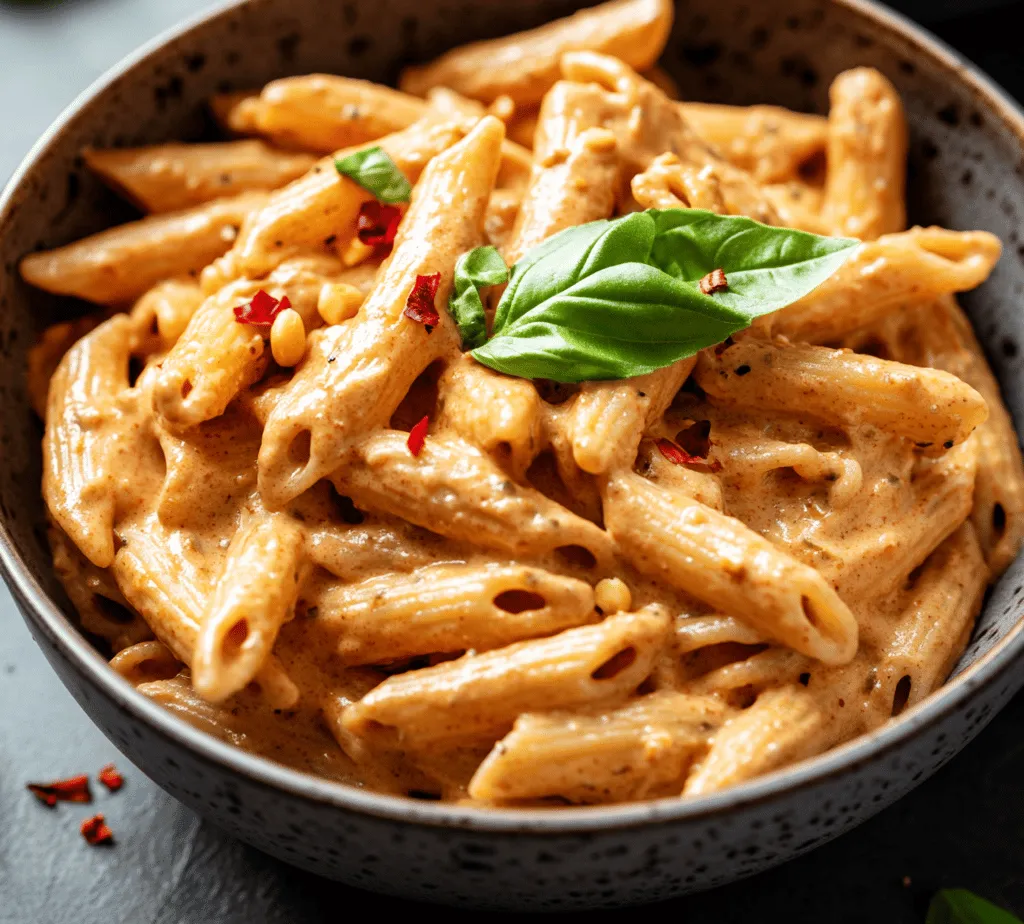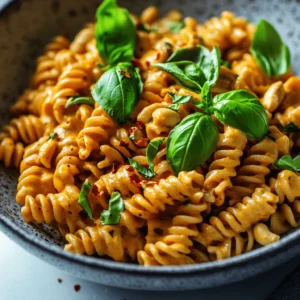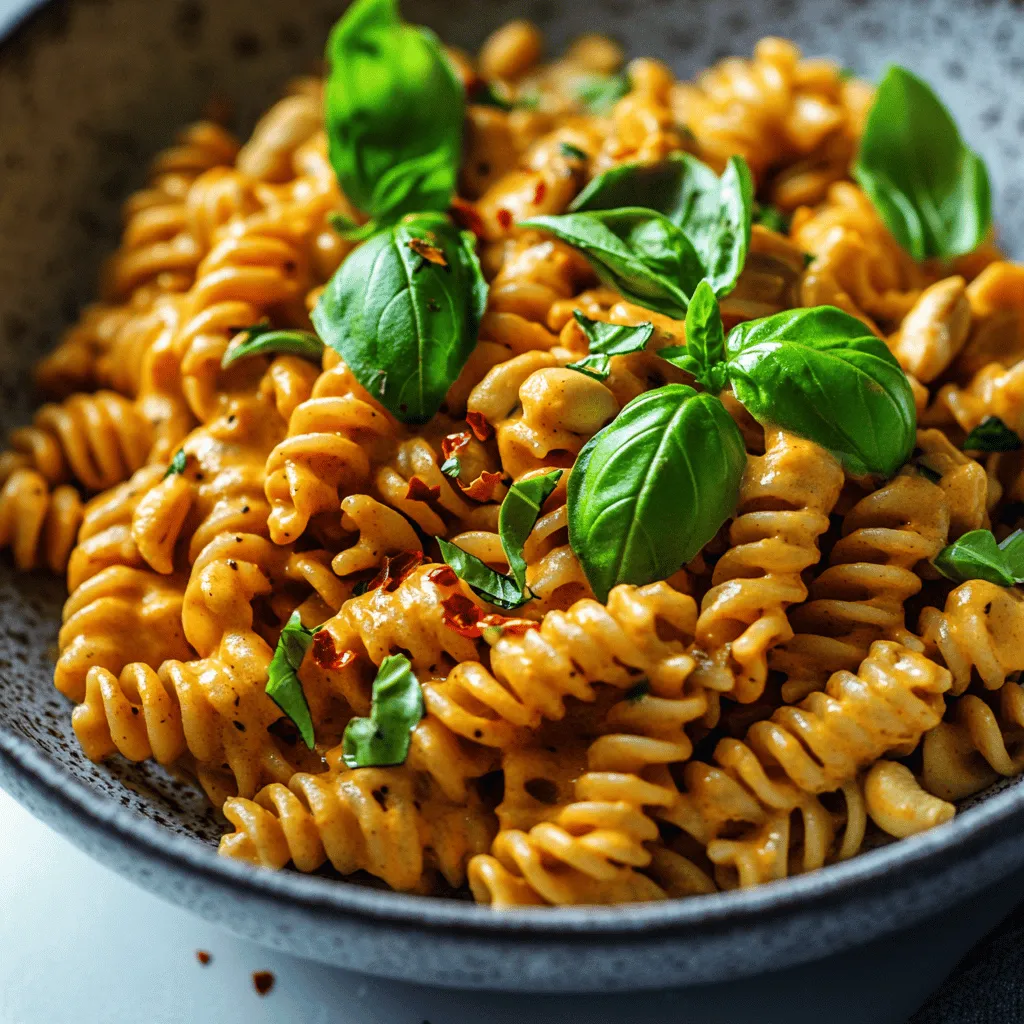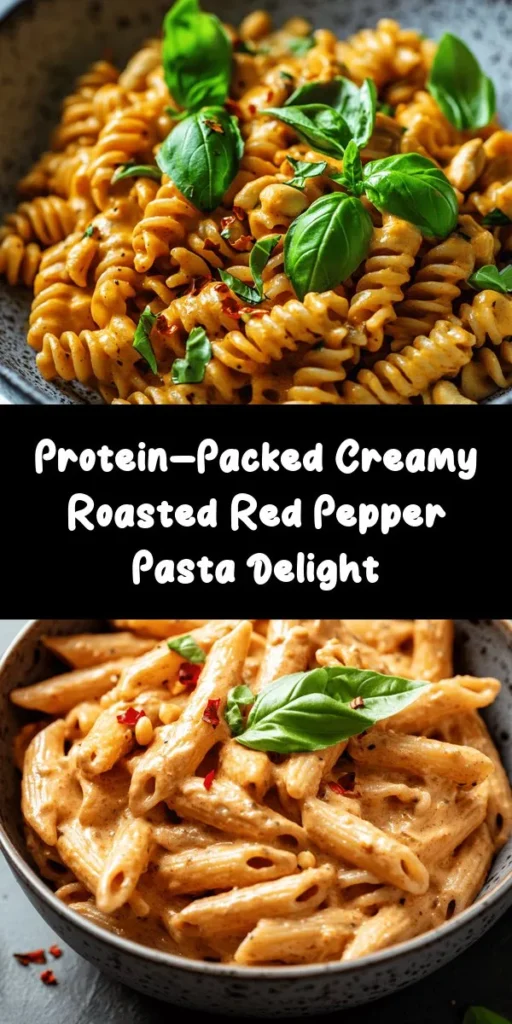Introduction
In recent years, the demand for high-protein meals has surged among health-conscious individuals and fitness enthusiasts alike. This trend reflects a growing awareness of the essential role protein plays in our diets, from muscle repair to overall satiety. Among the myriad of options available, creamy pasta dishes have captured the hearts and taste buds of many, offering a comforting yet nutritious meal.
Introducing the “High Protein Creamy Roasted Red Pepper Pasta,” a delightful recipe that wonderfully balances indulgence with health. This dish is not only delicious but versatile enough to cater to both vegetarians and meat-eaters. By harnessing the natural sweetness of roasted red peppers and the creaminess of cashews, this pasta dish is transformed into a high-protein powerhouse. Utilizing wholesome ingredients ensures that every bite is not only satisfying but also rich in nutrients, making it a perfect addition to your weekly meal rotation.
The Nutritional Benefits of High Protein Pasta Dishes
Protein is a crucial macronutrient that plays various roles in our bodies. It is essential for building and repairing tissues, producing enzymes and hormones, and supporting immune function. Including adequate protein in your meals can aid in muscle recovery after workouts, enhance the feeling of fullness, and regulate appetite.
When it comes to pasta, the choice of base can significantly impact the nutritional value of the dish. Whole wheat and chickpea pastas are excellent alternatives to traditional white pasta. Whole wheat pasta retains the bran and germ of the grain, making it a source of fiber, vitamins, and minerals, while chickpea pasta offers a gluten-free option that’s high in protein and fiber, making it a favorite among those looking for plant-based protein sources.
The ingredients in this High Protein Creamy Roasted Red Pepper Pasta also contribute to its overall health benefits. Red bell peppers, known for their vibrant color and sweet flavor, are packed with vitamins A and C, antioxidants, and fiber. Cashews not only lend creaminess to the sauce but also provide healthy fats, magnesium, and other important nutrients. Nutritional yeast, often used as a cheese substitute, is rich in B vitamins and adds a savory, umami flavor to the dish. Together, these ingredients create a meal that not only satisfies your taste buds but also fuels your body.
Ingredients Breakdown
To create this delicious and nutritious High Protein Creamy Roasted Red Pepper Pasta, you’ll need a selection of wholesome ingredients that enhance flavor and nutritional content. Let’s take a closer look at each component and its role in this dish:
Whole Wheat or Chickpea Pasta
The choice between whole wheat and chickpea pasta depends on your dietary preferences and health goals. Whole wheat pasta is made from whole grains, offering more fiber and nutrients than its refined counterparts. It helps maintain digestive health and provides a steady release of energy. On the other hand, chickpea pasta is an excellent gluten-free alternative that is significantly higher in protein and fiber while being lower in carbohydrates. This makes it a stellar option for those looking to increase their protein intake while enjoying a pasta dish.
Red Bell Peppers
Red bell peppers are the star ingredient in this recipe. When roasted, they develop a sweet, smoky flavor that infuses the pasta with depth and richness. Nutritionally, red bell peppers are an excellent source of vitamins A and C, which are crucial for immune health and skin integrity. They are also low in calories and high in antioxidants, making them a healthy addition to any meal.
Cooked Chicken Breast or Chickpeas
For those looking to add extra protein, cooked chicken breast is a fantastic choice. It’s lean, packed with protein, and versatile enough to pair with various flavors. If you prefer a plant-based option, chickpeas are a great alternative. They not only provide protein but also contribute fiber, keeping you full and satisfied.
Cashews
Cashews play a vital role in creating the creamy texture of the sauce. When blended, soaked cashews transform into a smooth and rich base that mimics the creaminess of dairy without the added calories and fat. They also provide healthy fats, aiding in nutrient absorption and contributing to heart health.
Vegetable or Chicken Broth
To enhance the flavor and moisture of the sauce, vegetable or chicken broth is essential. It serves as a flavorful liquid base that prevents the sauce from becoming too thick while adding depth to the overall taste. Opt for low-sodium varieties to keep the dish healthier.
Nutritional Yeast
Nutritional yeast is a unique ingredient that provides a cheesy flavor without any dairy. It is packed with B vitamins, including B12, which is particularly important for those on a plant-based diet. Adding nutritional yeast not only enhances the taste of the sauce but also boosts its nutritional profile.
Garlic and Olive Oil
Garlic is a staple in many cooking traditions, and for good reason. It adds a robust flavor while also offering numerous health benefits, including anti-inflammatory properties and potential immune-boosting effects. Olive oil, especially extra virgin, serves as a healthy fat source and enhances the dish’s richness, making it even more satisfying.
Smoked Paprika
For an extra layer of flavor, smoked paprika is a wonderful addition. It imparts a subtle smokiness to the sauce, complementing the sweetness of the roasted red peppers and enhancing the overall taste profile of the dish.
Fresh Basil and Red Pepper Flakes
Finally, fresh basil and red pepper flakes are used as garnishes to elevate the dish further. Fresh basil adds a burst of freshness, while red pepper flakes provide a hint of heat, allowing you to customize the dish according to your taste preferences.
Step-by-Step Guide to Making High Protein Creamy Roasted Red Pepper Pasta
Now that we have a comprehensive understanding of the ingredients and their benefits, let’s dive into the preparation of the High Protein Creamy Roasted Red Pepper Pasta. This section will guide you through the initial steps required to create this delicious meal.
Preparation Steps
Preparing your ingredients beforehand makes the cooking process smoother and more enjoyable. Here’s how to get started:
1. Soak the Cashews: Begin by soaking the cashews in water for at least 2 hours or overnight if possible. Soaking softens the nuts, making them easier to blend into a creamy sauce. If you’re short on time, you can also soak them in hot water for about 30 minutes.
2. Chop the Vegetables: While the cashews are soaking, wash and chop the red bell peppers into halves or quarters, removing the seeds and stems. Additionally, mince the garlic to enhance its flavor in the sauce.
3. Cook the Pasta: Bring a large pot of salted water to a boil. Add your choice of whole wheat or chickpea pasta and cook according to the package instructions until al dente. Drain the pasta and set it aside, reserving a cup of the pasta cooking water for later.
Importance of Equipment
Having the right kitchen tools can significantly impact your cooking experience. For this recipe, you will need:
– Roasting Tray: A baking sheet or roasting tray for roasting the red bell peppers.
– Blender: A high-speed blender or food processor to create the creamy sauce from the soaked cashews and roasted peppers.
– Large Pot: For cooking the pasta and combining all the ingredients.
– Wooden Spoon or Tongs: For tossing the pasta with the sauce.
– Knife and Cutting Board: Essential for chopping vegetables and preparing ingredients.
Roasting the Bell Peppers
Roasting the red bell peppers is a crucial step that elevates the flavor of the dish.
1. Preheat your oven to 425°F (220°C).
2. Place the chopped red bell peppers on the roasting tray, cut side down.
3. Drizzle with olive oil and sprinkle with salt and pepper to taste.
4. Roast in the preheated oven for about 25-30 minutes or until the skins are blistered and charred.
5. Once roasted, remove the tray from the oven and let the peppers cool slightly. When cool enough to handle, peel off the skins, which will come off easily, and set the roasted peppers aside.
With these initial steps complete, you are well on your way to creating a delightful High Protein Creamy Roasted Red Pepper Pasta that is not only nutritious but also bursting with flavor. In the next section, we will dive deeper into creating the creamy sauce and bringing the dish together. Stay tuned for more culinary insights and helpful tips to ensure your pasta turns out perfectly every time.

Detailed Instructions for Roasting
To achieve the perfect char on your red peppers, start by preheating your oven to 450°F (232°C). This high temperature is crucial for blistering the skin, which enhances the flavor of the peppers.
1. Preparation: Rinse and dry the red peppers. Cut them in half lengthwise, removing the seeds and stems. For a more intense flavor, consider cutting off the tops and leaving them whole; this will result in a more dramatic roasting effect.
2. Roasting: Place the peppers cut side down on a baking sheet lined with parchment paper. This will help catch the juices that drip down during roasting, making cleanup easier. Roast the peppers for about 25-30 minutes, or until the skin is blackened and blistered. Keep an eye on them to avoid burning.
3. Steaming for Peeling: Once roasted, remove the peppers from the oven. Transfer them to a bowl and cover with plastic wrap or a kitchen towel. The steam created will help loosen the skin, making it easier to peel off. Let them sit for about 10-15 minutes.
4. Peeling: After steaming, use your fingers or a paper towel to gently rub off the charred skin. Don’t worry if some bits remain; they can add a smoky flavor to your pasta.
Cooking the Pasta
Choosing the right pasta is essential for this recipe. Opt for a pasta that can hold the creamy sauce well, such as penne, fusilli, or rigatoni. These shapes allow the sauce to cling to every bite, enhancing the overall flavor.
1. Water Preparation: Fill a large pot with water, ensuring there’s enough to allow the pasta to move freely. For every 4 quarts of water, add at least a tablespoon of salt. This is vital as it seasons the pasta from the inside out.
2. Cooking Al Dente: Bring the water to a rolling boil before adding your pasta. Follow the package instructions for cooking time, but start checking for doneness a minute or two early. The pasta should be al dente, firm to the bite.
3. Timing: Reserve a cup of pasta water before draining. This starchy water can be used to adjust the sauce’s consistency later on. Drain the pasta in a colander but do not rinse; rinsing washes away the starch that helps the sauce adhere.
Making the Creamy Sauce
Creating the creamy sauce is where the magic happens, transforming simple ingredients into a rich, flavorful dish.
1. Blending Instructions: In a high-speed blender, combine the roasted red peppers, a tablespoon of olive oil, nutritional yeast (for a cheesy flavor), garlic, and a splash of lemon juice. Blend until smooth. You can adjust the thickness of the sauce by adding some reserved pasta water if needed.
2. Adjusting Flavors: Taste the sauce before finishing it. You may want to add more salt, pepper, or lemon juice. For a touch of heat, consider adding a pinch of red pepper flakes or cayenne. Blend again to incorporate.
3. Texture Customization: If you prefer a chunkier sauce, blend only half of the roasted peppers and leave the other half diced, adding them back into the sauce after blending.
Combining Pasta and Sauce
Once the sauce is ready, it’s time to bring everything together.
1. Coating the Pasta: In a large mixing bowl, combine the drained pasta and the creamy sauce. Use tongs or a large spoon to mix thoroughly, ensuring that every piece of pasta is coated evenly.
2. Heating the Mixture: Transfer the pasta and sauce mixture to a large skillet over medium heat for a couple of minutes. This will help meld the flavors together and warm the dish evenly. If the sauce seems too thick, add a little reserved pasta water to reach your desired consistency.
Serving Suggestions
Presentation is key to making this dish as appealing as it is delicious.
1. Visual Appeal: Serve the pasta in shallow bowls to showcase the vibrant color of the sauce. Sprinkle freshly chopped basil or parsley on top for a burst of color and freshness.
2. Pairing Options: Complement your meal with a light side salad dressed in a lemon vinaigrette or some crispy garlic bread to soak up any remaining sauce. A glass of white wine, such as Pinot Grigio, pairs beautifully with the roasted red pepper flavor.
Flavor Variations and Add-Ins
This recipe is incredibly versatile, allowing for numerous customizations based on your preferences or seasonal availability.
1. Seasonal Vegetables: Consider adding sautéed zucchini, spinach, or cherry tomatoes for added nutrition and texture. Simply toss these in the skillet before adding the pasta, allowing them to soften slightly.
2. Adjusting Spice Levels: If you enjoy a bit of heat, increase the amount of red pepper flakes or even add a diced jalapeño while blending the sauce. Conversely, for a milder flavor, skip the spice or reduce it significantly.
3. Alternative Protein Sources: For a vegetarian or vegan option, incorporate diced tofu or tempeh. Sauté them in olive oil until golden before adding them to the pasta mix. This will add a hearty protein punch to your dish.
4. Gluten-Free Options: You can easily make this dish gluten-free by substituting regular pasta with gluten-free alternatives made from rice, quinoa, or chickpeas. These options maintain a delightful texture while accommodating dietary needs.
Storing and Reheating Leftovers
If you find yourself with leftovers, proper storage and reheating techniques are essential to maintaining the dish’s quality.
1. Best Practices for Storing: Allow the pasta to cool completely before transferring it to an airtight container. Refrigerate it for up to 4 days. If you’re storing it for longer, consider freezing the sauce separately from the pasta to preserve texture.
2. Reheating Methods: The best way to reheat your pasta is in a skillet over medium heat. Add a splash of water or broth to help revive the sauce’s creaminess. Stir frequently to prevent sticking. Alternatively, you can microwave it in short intervals, stirring in between, until heated through.
3. Flavor Development: Interestingly, the flavors of the pasta dish may deepen and improve after sitting for a day. This makes it a great make-ahead meal for busy weeknights.
Conclusion
The High Protein Creamy Roasted Red Pepper Pasta is not just a meal; it’s a celebration of vibrant flavors, nourishing ingredients, and culinary creativity. With its rich, creamy texture and the warmth of roasted peppers, it promises satisfaction in every bite. This dish is not only nutrient-dense but also easy to prepare, making it perfect for busy lifestyles where health and flavor are priorities.
We encourage you to try this recipe for a delicious, healthy dinner option. With its versatility, you can easily adapt it to suit your taste or dietary preferences. Whether you choose to stick to the classic version or experiment with different add-ins and variations, this pasta will undoubtedly become a favorite in your household. Enjoy your culinary adventure, and relish the creamy delight of this high-protein dish!



